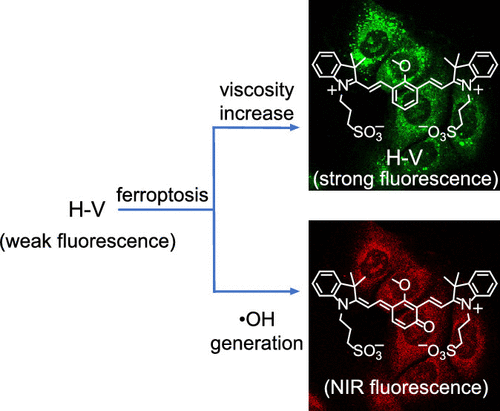Ferroptosis Accompanied by ?OH Generation and Cytoplasmic Viscosity Increase Revealed via Dual-Functional Fluorescence Probe
Ferroptosis is a newly discovered regulated cell death process. Unlike apoptosis, ferroptosis results from the iron-dependent accumulation of lipid peroxides, which is closely associated with reactive oxygen species (ROS). Nevertheless, it is uncertain which ROS plays a key role in the lipid peroxidation during ferroptosis. Evidence has indicated that hydroxyl radical (·OH), the most active ROS, is capable of initiating lipid peroxidation. Moreover, similar to ferroptosis, the generation of ?OH in biosystems is involved in the participation of iron. Therefore, it is reasonable to presume that the overproduction of ·OH might be an important cause of lipid peroxidation in ferroptosis. However, no study on this topic has been reported, and it remains unknown how the ·OH levels vary during ferroptosis. On the other hand, cytoplasmic viscosity is a basic factor of living cells, and the increase of cytoplasmic viscosity is one of the most important morphological features of apoptosis. As ferroptosis is morphologically distinct from apoptosis, it is significant to disclose whether ferroptosis is accompanied by cytoplasmic viscosity alteration.
Recently, a research team led by Prof. MA Huimin from Institute of Chemistry, Chinese Academy of Sciences (CAS), characterized for the first time the changing behavior of ·OH and cytoplasmic viscosity during ferroptosis using a dual-functional fluorescence probe (H-V).
The researchers designed probe H-V via the molecular rotor strategy and the unique aromatic hydroxylation of ·OH. With the increase in microenvironmental viscosity, the intramolecular rotation of H-V is restricted, leading to fluorescence enhancement at 520 nm. For ·OH detection, the specific hydroxylation by ·OH and subsequent structure rearrangement led to the π-conjugation extension of H-V, thereby showing a large spectral red shift and a sharp NIR fluorescent off-on response at 652 nm. This allows the independent detection of ·OH and viscosity in two different channels. With H-V the researchers found that ferroptosis is accompanied by noticeable ·OH generation, cytoplasmic viscosity increase and accelerated lipid droplet formation. Most notably, the raised ·OH comprises the majority of the total ROS in ferroptosis, and is probably the main cause of lipid peroxidation, which thus leads to the increase of cytoplasmic viscosity and the accelerated formation of lipid droplet
The study entitled “Ferroptosis accompanied by ·OH generation and cytoplasmic viscosity increase revealed via dual-functional fluorescence probe” was published in J. Am. Chem. Soc. (2019, 141, 18301-18307). The research was supported from the National Natural Science Foundation of China, the 973 Program, CAS, and Youth Innovation Promotion Association of CAS.

The structure of probe H-V and its fluorescence imaging of ·OH and cytoplasmic viscosity during ferroptosis. (image by Prof. MA Huimin)
Contact:
Prof. MA Huimin
Institute of Chemistry, Chinese Academy of Sciences
Email: mahm@iccas.ac.cn





